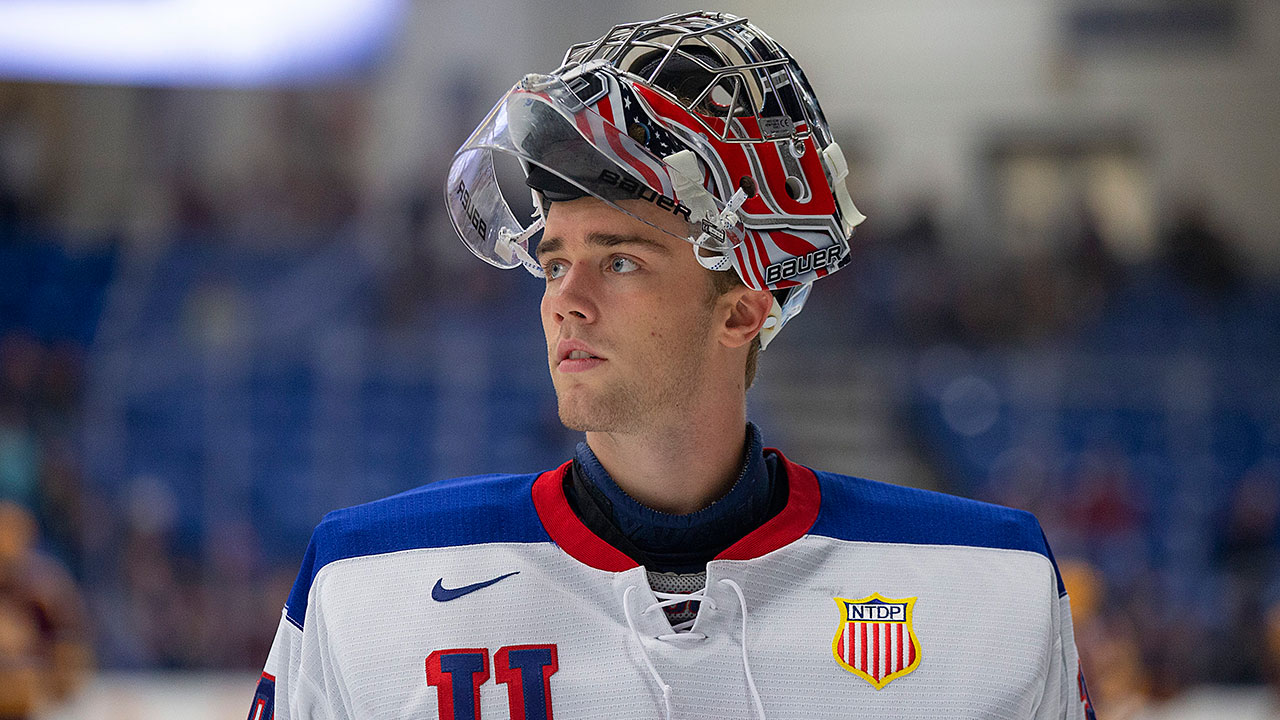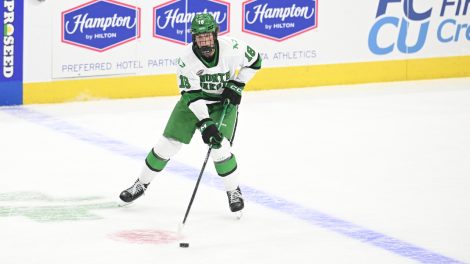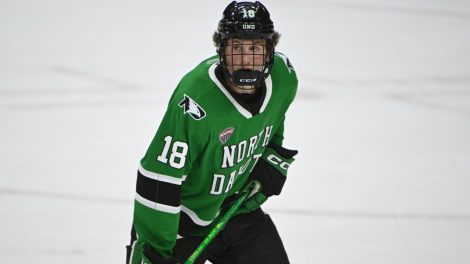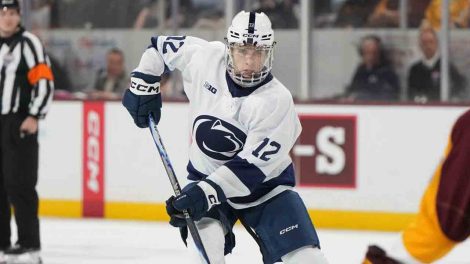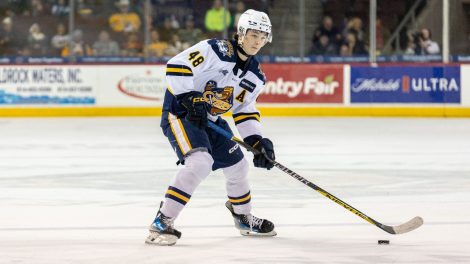All eyes are on the U.S. National Team Development Program heading into the 2019 NHL Draft, with Jack Hughes set for a podium finish and a lengthy list of his teammates bound for first-round assignments as well. But one of the most interesting of the bunch might just be the one standing calmly in the corner of the frame during all those high-flying Hughes highlights.
Alongside the NTDP’s crew of offensive stars, goaltender Spencer Knight looks set to earn a first-round selection of his own in 2019, which would make him just the seventh netminder selected in the opening round over the past decade.
“He’s probably going to be one of the surprises, if there is such a thing, in the draft, being picked in the first round,” says John Vanbiesbrouck, one of the best American-born goalies in history and now the assistant executive director of hockey operations for USA Hockey. “But just the value to the organization that selects him, I think they’re going to get a high value and a character type of person.”
While Knight’s turned heads with the flashier elements of his game, it’s the work the Darien, Conn., native consistently puts in before he takes the ice that’s impressed Vanbiesbrouck most over the course of their time together.
“It’s the unseen things, really. I think most people would say, ‘I love the way he handles the puck’ and I think that’s going to be very apparent. But for me, it’s the way that he approaches the game, his preparation for the game, the way that he cares about that and about his teammates,” says Vanbiesbrouck, who donned the Team USA sweater for 47 games as a junior and senior player, and logged 882 appearances in the pros over the course of his two decades in the NHL.
“He gives it his all, all the time. It’s a position that demands high preparation, and he’s really impressed me with the way that he approaches the game and his preparation. For a young goalie, he’s extremely mature in the way that he approaches it.”
The signs are all there that Knight has the foundation to be a difference maker at the highest level, but even so, there may be no science as inexact as drafting NHL goaltenders. Zero netminders heard their name called in the first round last year, and in the 15 years since Marc-Andre Fleury was selected first overall by Pittsburgh, only 19 have been tabbed in that first-round group — only seven of whom managed to live up to the hype.
With Knight likely to be the 20th netminder on that list, let’s take a look back at how each of those 19 first-rounders panned out for their draft clubs:
[relatedlinks]
Marc-Andre Fleury (1st overall, 2003)
Drafted By: Pittsburgh Penguins
Drafted From: QMJHL Cape Breton
How it played out: About as well as Pittsburgh could’ve hoped. Though he and the club endured a few lean early years, Fleury quickly became the bona fide No. 1 the Penguins sought when they selected him with the 2003 Draft’s first-overall pick. The Sorel, Que. native led the club to two Stanley Cup Final appearances in his fourth and fifth years in the league, the latter culminating in a Stanley Cup ring courtesy of an iconic last-second Fleury save in Game 7. ‘The Flower’ went on to earn two more Stanley Cup rings with Pittsburgh, before backstopping the Vegas Golden Knights to their first Cup Final run (his fifth) in 2018. An arguably Hall of Fame-worthy career makes Fleury the only one of the three netminders drafted first-overall in NHL history to live up to his lofty draft position.
Al Montoya (6th overall, 2004)
Drafted By: New York Rangers
Drafted From: University of Michigan
How it played out: Considering the names left on the board after Montoya was chosen sixth-overall in 2004, it’s safe to say the University of Michigan product didn’t pan out as hoped — although he didn’t wind up being the most disappointing of the four goalies selected in 2004’s first round. It took half a decade, a slew of ECHL and AHL appearances, and a trade to the Coyotes for Montoya to finally get his shot in the big leagues — a brief five games in 2009. The Chicago, Ill., native made his name as a journeyman backup from that point, his best campaigns coming with the Islanders (2010-11), Jets (2013-14) and Panthers (2015-16).
Devan Dubnyk (14th overall, 2004)
Drafted By: Edmonton Oilers
Drafted From: WHL Kamloops
How it played out: Dubnyk’s career started off much the same as the netminder taken eight picks before him, as the Regina, Sask., native endured four seasons of ECHL and AHL action before getting his NHL shot. The tumult continued after making that jump, with Dubnyk playing out an up-and-down five-year stint in Edmonton before a trade sent him through Nashville and Arizona. On his fourth NHL stop in Minnesota Dubnyk enjoyed a career revival that helped him live up to his first-round billing. A dominant 2015-16 campaign with the Wild earned him a Bill Masterton Memorial Trophy, a Vezina Trophy nomination, and saw him finish fourth in Hart Trophy voting. Though he was unable to keep up that sterling level, Dubnyk has remained a fairly solid No. 1 ever since.
Marek Schwarz (17th overall, 2004)
Drafted By: St. Louis Blues
Drafted From: Czech Republic’s Sparta Praha
How it played out: The third of four goalies taken in Round 1 of the 2004 Draft, Schwarz wound up a cautionary tale for gambling on a goalie in the first round. The Czech goaltender never made it to the NHL for more than a cup of coffee, suiting up for only six total NHL games in his career — which came in two-game stretches split between three different seasons. His lone shining moment came in 2008, when Schwarz was called into action for the Blues with the three goalies above him on the depth chart — Manny Legace, Chris Mason and Ben Bishop — all sidelined by injury. Fifteen clean minutes earned him a combined shutout with Bishop, but wouldn’t wind up enough to keep Schwarz in the big leagues.
Cory Schneider (26th overall, 2004)
Drafted By: Vancouver Canucks
Drafted From: Phillips Academy Andover
How it played out: The final goalie taken in the 2004 Draft’s first round might just be the one who panned out the best. Though he never reached the dominant level Dubynk did in his Vezina-nominated season, Schneider’s put together a steady and solid career in the NHL — first in tandem with Roberto Luongo in Vancouver, and then as the No. 1 in New Jersey following a 2013 trade. The Marblehead, Mass., native earned a William M. Jennings Trophy alongside Luongo in 2010-11, eventually leaving Vancouver with a dominant .927 save percentage. Schneider’s Devils stint started off well, finishing his first three seasons in New Jersey with a .924 save percentage before injuries started to take their toll.
Carey Price (5th overall, 2005)
Drafted By: Montreal Canadiens
Drafted From: WHL Tri-City
How it played out: Much like Fleury, little needs to be said about how Montreal’s first-round bet on Price turned out. Highly touted before he arrived and impressive early on, Price has become an undeniable force over his 12-year career, and annually one of the best in the game. Though there have been hiccups along the way — most notably the 2009-10 season that saw him lose the net to Jaroslav Halak — his tenure in Montreal will be remembered most for the dominant 2014-15 campaign that saw Price rack up the Vezina Trophy, Lester B. Pearson Award, and William M. Jennings Trophy, while becoming just the seventh netminder to ever claim the Hart Trophy.
Tuukka Rask (21st overall, 2005)
Drafted By: Toronto Maple Leafs
Drafted From: Finland’s Ilves Tampere Jr.
How it played out: It depends on whose perspective we’re talking about. It’s been swell for Rask and the club his name would eventually become synonymous with. For Toronto? Not so much. After tabbing Rask with the 21st-overall pick, the Maple Leafs famously traded him to the Boston Bruins before he played a single game in Toronto. In his third season with the Bruins, Rask led the league with a .931 save percentage and 1.97 goals-against average, before winning the Cup as Tim Thomas’ backup in 2011. In the years since, he’s blossomed into an annually elite No. 1, winning the Vezina Trophy in 2014 and guiding the Bruins back to the Cup Final twice.
Jonathan Bernier (11th overall, 2006)
Drafted By: Los Angeles Kings
Drafted From: QMJHL Lewiston
How it played out: There have been times here and there when Bernier’s looked the part of first-round talent, but overall he never lived up to the top-tier pick used to bring him to Los Angeles, especially given some of the names left on the board after him. Bernier’s finest season came in his first as a starter with the Maple Leafs — he finished with a solid .922 save percentage through 55 games — but aside from two seasons in Toronto, he’s made his mark primarily as a big-league backup. From the Kings’ perspective, he may have been good enough, helping L.A. win a Stanley Cup in 2012 (as Jonathan Quick’s backup) and eventually being shipped out of town in exchange for some of the assets used to trade for Marian Gaborik, who helped the Kings claim a second Cup in 2014.
Riku Helenius (15th overall, 2006)
Drafted By: Tampa Bay Lightning
Drafted From: Finland’s Ilves Tampere
How it played out: Another cautionary first-round tale, Helenius wound up a certified bust after being selected 15th overall by the Lightning in 2006. He logged only 6:52 minutes in the big leagues over the course of his career, coming on in relief of Mike Smith for the latter portion of one game against the Flyers in 2009. He faced two shots, stopped them both. Aside from that, Helenius’ career spanned a slew of seasons split between the ECHL and AHL, along with stints in Sweden, Finland and Russia. This one likely stings a bit more given the netminder chosen just eight picks later.
Semyon Varlamov (23rd overall, 2006)
Drafted By: Washington Capitals
Drafted From: Russia’s Lokomotiv Yaroslavl 2
How it played out: Varlamov wound up being the winningest goalie of his draft class, tallying 213 through 448 career NHL appearances. It certainly hasn’t been smooth sailing for the Russian netminder, though. While Varlamov had a few promising years in Washington, the Capitals traded him away after just 59 appearances for the club, getting back a package that included the pick used to draft Filip Forsberg. Varlamov emerged as a legitimate No. 1 option in Colorado, however, earning a Vezina Trophy nomination in 2014 while finishing fourth in Hart Trophy voting.
Leland Irving (26th overall, 2006)
Drafted By: Calgary Flames
Drafted From: WHL Everett
How it played out: Fresh off an impressive junior career, the Alberta native never managed to make an impact in Calgary after earning a first-round shot, appearing in just 13 games for the Flames over the course of two seasons. Struggling to make it out of the AHL ranks during his tenure under contract with the Flames, Irving eventually made the jump to Europe and continued his career overseas. Unfortunately for Calgary, eventual NHL regular Michal Neuvirth was tabbed just eight picks later, early in the second round.
Chet Pickard (18th overall, 2008)
Drafted By: Nashville Predators
Drafted From: WHL Tri-City
How it played out: The older brother of Avalanche and Maple Leafs alum Calvin Pickard, Chet Pickard never found the same level of success at the NHL level. The elder Pickard earned his high draft stock off a dominant junior career that saw him named 2008 WHL and CHL goaltender of the year. Unable to stick with the Predators’ AHL squad after they selected him 18th overall in 2008, he was bumped down to the ECHL and eventually moved on to Sweden. A brief foray back into the AHL and ECHL was followed by a move back overseas to the German league.
Thomas McCollum (30th overall, 2008)
Drafted By: Detroit Red Wings
Drafted From: OHL Guelph
How it played out: Chosen one pick before Jakob Markstrom, and four before Jake Allen, McCollum wound up a misfire for the Red Wings, who added him with the final pick of the first round in 2008. Bouncing between the AHL and ECHL, doing little to impress in either, McCollum earned one NHL appearance with the Red Wings in 2011 — he allowed three goals on eight shots in 14-and-a-half minutes against the Blues, after starter Joey MacDonald had already been shelled for seven against. A few more years of AHL play earned McCollum two more appearances with Detroit in 2015, wherein he allowed just one goal through 66 total minutes between those two games, but he’s been primarily an AHLer since then.
Jack Campbell (11th overall, 2010)
Drafted By: Dallas Stars
Drafted From: USNTDP
How it played out: The book on Campbell is still being written, it seems. Drafted 11th overall in 2010, ahead of a fair few eventual all-stars, Campbell made his name as a standout with Team USA — backstopping his national side to three gold medals in different competitions — while failing to make much of an impact at the club level. Struggling to live up to the hype with the Stars, Campbell was traded to L.A. in 2016. It wasn’t until this past season that he started to show signs of life, earning 31 games at the NHL level and posting a .928 save percentage in that span. While he could still wind up as an NHL No. 1 in L.A. or elsewhere, it’s clear the Stars’ gamble on the first-rounder did little to impact their own success.
Mark Visentin (27th overall, 2010)
Drafted By: Phoenix Coyotes
Drafted From: OHL Niagara
How it played out: The second first-rounder drafted in 2010, Visentin’s career went much the same as Campbell’s, without the eventual revival. The former Team Canada juniors netminder bounced between the AHL and ECHL before getting one game in the show for the Coyotes — he saved 29 of 32 in a loss to the Sharks, and never made it back to the NHL. Another cautionary tale of a first-round goalie who perhaps earned some NHL acclaim through international performances, but unfortunately wound up unable to put it all together at the NHL level.
Andrei Vasilevskiy (19th overall, 2012)
Drafted By: Tampa Bay Lightning
Drafted From: Russia’s Ufa 2
How it played out: Already one of the most successful netminders on this list in just his third year as a bona fide starter. Tabbed at 19th overall, Vasilevskiy played out a couple years in Russia and one AHL campaign before graduating to the NHL. Quietly solid as a backup to Ben Bishop, who earned Vezina nominations at the time, Vasilevskiy eventually blossomed into a strong enough prospect that the Lightning traded Bishop to the Kings in 2017. The young Russian took over the starter role, and has looked dominant since. In his first full season as the No. 1, Vasilevskiy posted a .920 save percentage, led the league with eight shutouts, and earned his first Vezina Trophy nomination. Still only 24 years old, backstopping a team stocked with star power, he’s been precisely what the Lightning had hoped he would be thus far.
Malcolm Subban (24th overall, 2012)
Drafted By: Boston Bruins
Drafted From: OHL Belleville
How it played out: Selected five spots after Vasilevskiy, Subban posted some strong AHL campaigns for the Bruins’ affiliate, but never had much of a chance to shine at the NHL level with Rask entrenched as Boston’s No. 1 option. After earning two NHL games through his first four years with the organization, the Toronto, Ont. native was claimed off waivers by the Golden Knights in 2017. Given a greater opportunity to prove his worth, he shone for Vegas — debuting for his new club with a 21-save win over his former one. The 25-year-old Subban helped Vegas earn wins in 12 of his first 14 games with the club, and has since been a fairly reliable backup for Marc-Andre Fleury.
Ilya Samsonov (22nd overall, 2015)
Drafted By: Washington Capitals
Drafted From: Russia’s Magnitogorsk 2
How it played out: It’s too early to judge how 22nd-overall pick Samsonov will work out for the Capitals. There’s certainly no need for the young Magnitogorsk native to make waves in the NHL just yet, with Braden Holtby holding down the No. 1 job for the foreseeable future. Samsonov posted a couple strong seasons following his draft year, before moving on to the Capitals’ AHL affiliate, with 2018-19 his first year with the Hershey Bears. It was an up-and-down North American debut season, finishing with three shutouts and an .898 save percentage, but at 22 years old, he’s a ways off from being heavily relied upon at the top level.
Jake Oettinger (26th overall, 2017)
Drafted By: Dallas Stars
Drafted From: Boston University
How it played out: With no netminders selected in the first round of the 2018 NHL Draft, the most recent is 2017 26th-overall pick Oettinger. Much like the rest of his draft class — aside from its top end — Oettinger has yet to break out in the pros. Like Samsonov, he logged a strong post-draft season (his coming for Boston University) before making his first foray into pro life via the Stars’ AHL affiliate. Through six games with the Texas Stars, Oettinger allowed 15 goals and earned three wins. The 20-year-old has plenty of time to make good on his first-round selection, with Bishop and Anton Khudobin holding down the big club’s net for the time being.
